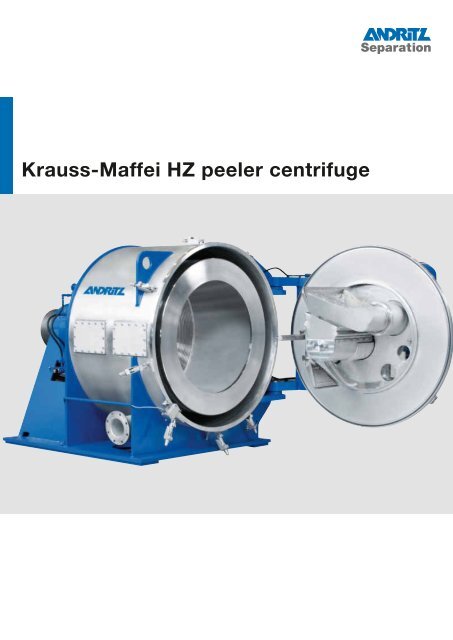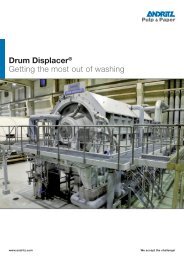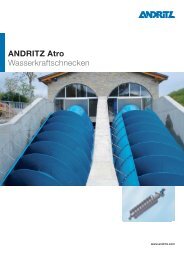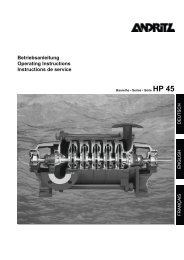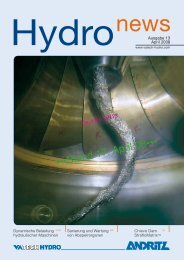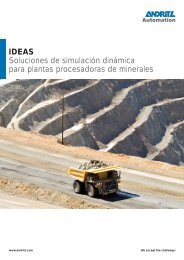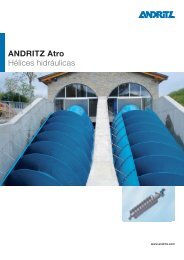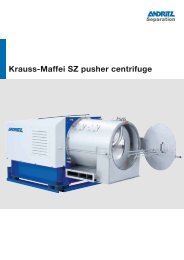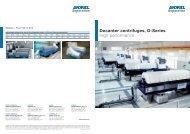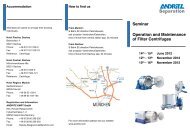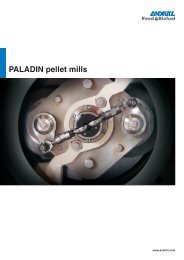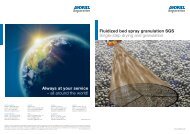Krauss-Maffei HZ peeler centrifuge - Andritz
Krauss-Maffei HZ peeler centrifuge - Andritz
Krauss-Maffei HZ peeler centrifuge - Andritz
You also want an ePaper? Increase the reach of your titles
YUMPU automatically turns print PDFs into web optimized ePapers that Google loves.
<strong>Krauss</strong>-<strong>Maffei</strong> <strong>HZ</strong> <strong>peeler</strong> <strong>centrifuge</strong>
2<br />
<strong>Krauss</strong>-<strong>Maffei</strong> <strong>HZ</strong> <strong>peeler</strong> <strong>centrifuge</strong><br />
Table of contents<br />
<strong>Krauss</strong>-<strong>Maffei</strong> <strong>peeler</strong> <strong>centrifuge</strong>, <strong>HZ</strong> 3<br />
Process advantages 4<br />
Basket designs 5<br />
Operation 6<br />
Centrifuge controls 8<br />
Process automation 9<br />
Foundation/installation 10<br />
Dimensions and weights 11<br />
Technical data 11<br />
Test centers 12<br />
Services 13<br />
Company profile 14<br />
Product lines 15
<strong>Krauss</strong>-<strong>Maffei</strong> <strong>HZ</strong> <strong>peeler</strong> <strong>centrifuge</strong><br />
Maximum efficiency<br />
<strong>Krauss</strong>-<strong>Maffei</strong> horizontal <strong>peeler</strong> cen-<br />
trifuges are batch operated filtration<br />
<strong>centrifuge</strong>s known for their reliable<br />
performance at high capacities. They<br />
are used in many processes, primarily<br />
in the bulk chemicals, fine chemicals,<br />
and food industries.<br />
The horizontal rotor assembly is cantilevermounted<br />
and, depending on the application,<br />
can be provided with a conventional<br />
filtration basket or a specially designed rotary<br />
siphon basket. A fully opening housing<br />
door provides access to the basket and all<br />
process components for maintenance.<br />
Adding variable speed drives and customtailored<br />
controls and instrumentation enables<br />
the <strong>peeler</strong> <strong>centrifuge</strong> to be optimally<br />
adapted to a multitude of processing requirements<br />
for peak performance.<br />
<strong>Krauss</strong>-<strong>Maffei</strong> <strong>peeler</strong> <strong>centrifuge</strong>, <strong>HZ</strong> 125/3.2 Si<br />
Main applications<br />
■ Bulk chemicals<br />
(Petrochemical intermediates, fertilizers,<br />
chlorides, sulfates, calcium<br />
compounds, sodium compounds)<br />
■ Fine chemicals<br />
(Aluminum fluoride, amino acids,<br />
bleaching agents, surfactants, herbicides,<br />
pesticides, catalysts, dyestuffs)<br />
■ Pharmaceuticals/related<br />
(APIs, vitamins, salicylic acid, citric<br />
acid, ascorbic acid, calcium citrate,<br />
antibiotics)<br />
■ Plastics/related<br />
(ABS, resins, melamine, PE, PP, antioxidant<br />
agents)<br />
■ Foodstuff/related<br />
(Native and modified starches, artificial<br />
sweeteners, vanillin, caffeine)<br />
Processing parameters<br />
Average particle size<br />
2-500 µm<br />
Feed solids concentration<br />
From 3.0% by wt.<br />
Solids throughput<br />
Up to 15 t/h<br />
Materials of construction<br />
for process wetted parts:<br />
■ Various grades of stainless steel<br />
■ Nickel-based alloys<br />
■ Special metals with or without lining<br />
3
4<br />
<strong>Krauss</strong>-<strong>Maffei</strong> <strong>HZ</strong> <strong>peeler</strong> <strong>centrifuge</strong><br />
Process advantages<br />
<strong>Krauss</strong>-<strong>Maffei</strong> <strong>peeler</strong> <strong>centrifuge</strong>, <strong>HZ</strong> 180/7.1<br />
<strong>Krauss</strong>-<strong>Maffei</strong> <strong>peeler</strong> <strong>centrifuge</strong>s<br />
with rotary siphon<br />
By utilizing the rotary siphon feature, an original<br />
ANDRITZ KMPT development, the overall<br />
performance of the <strong>peeler</strong> <strong>centrifuge</strong> can<br />
be improved considerably. Substantial advantages<br />
include:<br />
■ Increased filtration capacity<br />
Creation of a vacuum beneath the filter cloth<br />
increases the filtration pressure and boosts<br />
the filtration rate.<br />
■ Superior product purity<br />
The filtration rate can be adjusted to prolong<br />
the contact time by wash liquid and solids<br />
to produce a purer cake.<br />
■ Extended residual heel service life<br />
Regeneration of the residual heel is<br />
achieved by means of backwashing through<br />
the filter medium.<br />
■ Smoother operation<br />
Through backwashing and throttling of the<br />
filtration rate, the siphon feature enables<br />
feeding into a liquid pool for uniform distribution<br />
of solids without vibration, even with<br />
fast filtering products.<br />
Your benefits<br />
■ Unequaled flexibility<br />
<strong>Krauss</strong>-<strong>Maffei</strong> <strong>peeler</strong> <strong>centrifuge</strong>s can be<br />
adapted easily to changing process<br />
requirements. Different control recipes<br />
can be used to select the optimum<br />
operating speed and cycle sequence<br />
for yielding the highest product quality<br />
at peak capacity.<br />
■ Lower residual cake moisture<br />
due to high centrifugal forces.<br />
■ Excellent wash results<br />
through even distribution of wash liquid,<br />
achieved by horizontal basket configuration<br />
and feed via distributor or spray<br />
bars.
<strong>Krauss</strong>-<strong>Maffei</strong> <strong>HZ</strong> <strong>peeler</strong> <strong>centrifuge</strong><br />
Basket designs<br />
<strong>Krauss</strong>-<strong>Maffei</strong> <strong>peeler</strong> <strong>centrifuge</strong>s are<br />
furnished with various basket designs.<br />
The versions most frequently applied are the<br />
conventional filtration basket and the rotary<br />
siphon basket, an original ANDRITZ KMPT<br />
development.<br />
Filtration basket<br />
Of fabricated/welded or cast design, the fil-<br />
tration basket has a cylindrical shell with fil-<br />
trate bores through which the filtrate is spun<br />
out into the filtrate housing after passing<br />
through the filter medium.<br />
Filtration basket Rotary siphon basket<br />
Rotary siphon basket<br />
Contrary to the conventional perforated<br />
basket, the rotary siphon basket has a solid<br />
cylindrical shell with filtrate bores arranged<br />
radially at the rear end of the basket, where<br />
they are connected to a siphon-shaped<br />
chamber. Once it has penetrated the filter<br />
cake and the filter medium, the filtrate is<br />
redirected through axial channels beneath<br />
filter medium support segments into the<br />
siphon chamber where a pivoting skimmer<br />
pipe extracts it from the <strong>centrifuge</strong> under<br />
positive pressure. The radial distance between<br />
the filter medium and the liquid level<br />
in the siphon chamber increases the driving<br />
force and thus the filtration rate.<br />
5
6<br />
<strong>Krauss</strong>-<strong>Maffei</strong> <strong>HZ</strong> <strong>peeler</strong> <strong>centrifuge</strong><br />
Operation<br />
Feeding<br />
The suspension is introduced into the rotating<br />
<strong>centrifuge</strong> basket via the feed distributor.<br />
Typically, this would include several intermittent<br />
feed pulses to prevent the suspension<br />
from spilling over the basket rim. The fill<br />
level is monitored and regulated by a feed<br />
controller. Normally, the basket is filled with<br />
solids up to 75-80% of the basket rim<br />
height. The feed step is complete when the<br />
filter cake has reached the desired level.<br />
Filtration<br />
Primary filtration of the mother liquor<br />
through the filter medium installed in the<br />
basket begins with the feed step and<br />
ends when the liquor has submerged into<br />
the filter cake. The solids retained on the filter<br />
medium after completion of a cycle and<br />
discharge of product serve as a filter<br />
medium for subsequent cycles.<br />
Washing<br />
A cake wash step will often follow the primary<br />
filtration step. Wash liquid is introduced<br />
through the feed distributor or,<br />
for lower wash rates, through a separate<br />
spray bar. The wash liquid level is again<br />
monitored by the feed controller and<br />
the wash step is concluded once the predetermined<br />
amount of wash liquid has<br />
been used and the liquid submerges into<br />
the filter cake.<br />
Dry spinning<br />
Immediately following the feed and wash<br />
step, which may be carried out at a lower<br />
speed, the basket is accelerated to maximum<br />
allowable speed for the cake dry spinning<br />
step which ends when the desired<br />
residual cake moisture is reached, or after a<br />
predetermined spin time.<br />
Peeling/cake discharge<br />
At the end of each <strong>centrifuge</strong> cycle, the filter<br />
cake is removed from the basket by a pivoting<br />
peeling device equipped with a broad<br />
<strong>peeler</strong> knife. Depending on the product<br />
characteristics, the peeling motion is conducted<br />
at full or reduced basket speed with<br />
adjustable swivel advance velocity. The<br />
scraped layers of product are diverted into<br />
a trough and discharged from the <strong>centrifuge</strong><br />
through an inclined chute or a horizontal<br />
screw conveyor. To protect the filter<br />
medium, a thin layer of filter cake is retained<br />
in the basket. This layer, called the residual<br />
heel, becomes the filter aid for subsequent<br />
cycles.<br />
■ Discharge chute<br />
The peeled solids are accumulated and<br />
channeled to the outside of the <strong>centrifuge</strong><br />
by an inclining chute mounted on the housing<br />
door below the peeling device.<br />
■ Screw conveyor<br />
The peeled product is diverted to a horizontal,<br />
door-mounted screw conveyor which<br />
conveys the solids to the outside of the <strong>centrifuge</strong>.<br />
Advantages<br />
Solids<br />
■ Higher <strong>centrifuge</strong> throughput due to<br />
the potential of utilizing longer<br />
baskets.<br />
■ Usable for applications with solids<br />
exhibiting a tendency towards adhesion<br />
and with increased internal<br />
friction factors, both affecting gravity<br />
flow inherent to chute discharge configuration.<br />
Siphon basket feeding Siphon basket washing Siphon basket dry spinning<br />
Susp<br />
Fil
ension<br />
trate<br />
Backwashing<br />
With the rotary siphon basket it is possible<br />
to feed backwash liquid from an overhead<br />
mounted prime tank through the siphon<br />
chamber to permeate the residual heel from<br />
underneath. This process re-suspends the<br />
residual heel and restores its permeability. It<br />
also primes the rotary siphon for the next filtration<br />
cycle. The liquid pool on top of the<br />
heel created through backwashing will assist<br />
in evenly distributing the subsequent<br />
cycle’s incoming suspension, which will virtually<br />
eliminate the potential for imbalances<br />
during the feed step.<br />
Residual heel removal<br />
After frequent cycles, the residual heel may<br />
have compacted with enough fine solids to<br />
make it impermeable, resulting in poor filtration<br />
performance. When this occurs, the<br />
heel may be regenerated (by backwashing<br />
in siphon <strong>peeler</strong> <strong>centrifuge</strong>s) or removed<br />
pneumatically or hydraulically (in <strong>peeler</strong> <strong>centrifuge</strong>s<br />
with filtration baskets).<br />
■ Pneumatic heel removal<br />
By blowing either compressed air or nitrogen<br />
against the heel through special flat-jet<br />
nozzles mounted on a pivoting and oscillating<br />
manifold inside the basket, the heel cake<br />
is broken up into pieces and discharged by<br />
the peeling device.<br />
Siphon basket backwashing Discharge chute Screw conveyor<br />
■ Hydraulic heel removal<br />
Using the feed distributor, a large quantity of<br />
rinse liquid is introduced into the basket for<br />
a short period of time. The resulting shear<br />
forces create sufficient turbulence to lift<br />
the heel from the filter medium. The rinse liquid<br />
with the dispersed heel solids is discharged<br />
from the basket by the peeling<br />
device. This step requires diverting the liquid<br />
to outside the <strong>centrifuge</strong> away from the<br />
normal dry product discharge. The rinse liquid<br />
can be recycled to the main process or<br />
divided into heel solids and liquid in a separate<br />
process step.<br />
In both procedures, the heel is removed at<br />
low basket speeds to prevent tearing of the<br />
filter medium. The hydraulic heel removal<br />
step has the added advantage of simulta-<br />
neously cleaning the <strong>centrifuge</strong> interior. The<br />
most suitable removal procedure will de-<br />
pend upon the specific application.<br />
7
8<br />
<strong>Krauss</strong>-<strong>Maffei</strong> <strong>HZ</strong> <strong>peeler</strong> <strong>centrifuge</strong><br />
Centrifuge controls<br />
FKR TFKR UFKR<br />
Automatic and optimum operation of the<br />
<strong>centrifuge</strong> to yield a product with uniform<br />
quality at maximum capacity requires a sophisticated<br />
system for continuously monitoring<br />
and controlling a number of process<br />
and operating parameters, such as:<br />
■ Basket speed<br />
■ Feed time and basket fill level<br />
■ Filtration rate and spin time<br />
■ Wash ratio and wash time<br />
■ Safety related inputs, interlocks, position<br />
indicators, and other process-related instrument<br />
signals<br />
Typically, <strong>Krauss</strong>-<strong>Maffei</strong> <strong>peeler</strong> <strong>centrifuge</strong>s<br />
are provided with variable frequency drives<br />
for operating the <strong>centrifuge</strong> within a speed<br />
range best suited for each application<br />
and/or step in the process cycle. Programmable<br />
control electronics housed in local<br />
operator panels and/or in remote control<br />
cabinets evaluate the process signals and<br />
adapt process parameters on a result-dependent<br />
basis.<br />
The core controlling devices in <strong>peeler</strong> <strong>centrifuge</strong>s<br />
are feed controllers which provide<br />
the feedback signals for controlling the supply<br />
of product suspension,wash liquid, etc.,<br />
to the <strong>centrifuge</strong>.<br />
Feed controllers are available in various<br />
configurations:<br />
Standard paddle feed controller, FKR<br />
With spring-loaded/hydraulic pivoting motion<br />
or fully pneumatic operation.<br />
Thermal feed controller, TFKR<br />
The sensor arm of the TFKR with an embedded<br />
thermocouple is pivoted in and out<br />
at adjustable, regular intervals to touch the<br />
surface of the basket filling. The frictional<br />
heat between the sensor and the product<br />
generates a temperature signal which is<br />
conditioned and evaluated by an electronic<br />
controls module.<br />
The advantages of the TFKR are:<br />
■ The sensor can differentiate whether it<br />
touches a plane of liquid or the surface of<br />
solids due to the different frictional heat<br />
created by the contact. It can also determine<br />
both the level of basket filling and<br />
the filtrate immersion point which signals<br />
the end of the filtration or wash step.<br />
■ Adjustable immersion frequency and<br />
contact time of the TFKR sensor provides<br />
much more precise feedback on the<br />
prevalent processing conditions and allows<br />
for faster, more efficient <strong>centrifuge</strong><br />
cycles.<br />
Ultrasonic feed controller, UFKR<br />
The ultrasonic controller is a contact-free<br />
measurement system to detect the fill level<br />
in the basket. An ultrasonic probe emits a<br />
signal in the direction of the product in the<br />
basket. The signal reflected by the rising<br />
product is picked up by a sensor and analyzed<br />
by control electronics.<br />
The patented UFKR system by ANDRITZ<br />
KMPT offers the following benefits:<br />
■ Continuous level detection.<br />
■ No mechanical contact with the product,<br />
eliminating splashing or dusting.<br />
■ No mechanical wear on sensors, eliminating<br />
potential product contamination<br />
from eroded metal particles.<br />
■ No dynamic seals.<br />
■ Unobtrusive installation into the process<br />
area.
<strong>Krauss</strong>-<strong>Maffei</strong> <strong>HZ</strong> <strong>peeler</strong> <strong>centrifuge</strong><br />
Process automation • Installation<br />
Perfection in process engineering requires<br />
perfection in process automation.<br />
The superior performance of our process<br />
equipment is based on perfecting the interface<br />
between equipment hardware, electrical components,<br />
electronics, informatics, and process<br />
know-how to create an all-encompassing custom-tailored<br />
solution for each application. Using<br />
intelligent sensors and state-of-the-art communication<br />
systems, we control and monitor our<br />
machines on a result-oriented basis.<br />
Your benefits:<br />
■ Enhanced equipment performance<br />
■ Consistent high product quality<br />
■ Reduced consumption of utilities<br />
■ Optional status diagnostics<br />
Automation of machines<br />
Individual adaptation – we can incorporate<br />
the automation concepts for our machine<br />
into your existing control system.<br />
Custom concepts<br />
We provide an individually designed service<br />
package to fit your specification – from the<br />
control of individual units, to incorporation into<br />
existing control systems or automation of<br />
complete plants ready for operation.<br />
Services<br />
Based on your quality assurance program,<br />
we prepare all the required documents for<br />
validation and qualification of the automation<br />
software and hardware. Our extensive<br />
know-how, profound experience and innovative<br />
drive qualify us as your partner for validation<br />
of our equipment to meet your<br />
production needs.<br />
Machinery directives, ATEX, hazardous location<br />
regulations – there are many regulations<br />
to be met at the plant site. We are<br />
there to serve as your knowledgeable advisor<br />
for the safety of your plant.<br />
Installation<br />
Rotation of a <strong>centrifuge</strong> basket produces not<br />
only the centrifugal forces necessary for the<br />
separation of solids from liquids, but also high<br />
dynamic forces from the acceleration of considerable<br />
masses such as the weight of the<br />
Centrifuge installed on inertia block<br />
basket and its filling with product. Uneven<br />
distribution of the product within the basket<br />
creates imbalance forces which will be transmitted<br />
to the structure supporting the <strong>centrifuge</strong>.<br />
To keep the dynamic forces exerted<br />
on the structure to a minimum, the <strong>centrifuge</strong><br />
is best mounted on an isolation system<br />
which consists of additional mass (in the form<br />
of a steel or inertia block) supported by spring<br />
and damper elements.<br />
Installation guidelines:<br />
■ The feed pressure should be around<br />
0.5 bar.<br />
■ Keep all supply and discharge lines<br />
short and with a maximum possible<br />
gradient.<br />
■ All attachments to the <strong>centrifuge</strong> must<br />
be flexible.<br />
■ Provide for fast draining of all pipes<br />
either by venting or pressure compensation<br />
in closed loop systems.<br />
■ Install sight glasses and sample ports<br />
in all supply and discharge lines.<br />
■ Provide vertical solids drop without<br />
cross-sectional restrictions.<br />
9
10<br />
<strong>Krauss</strong>-<strong>Maffei</strong> <strong>HZ</strong> <strong>peeler</strong> <strong>centrifuge</strong><br />
Dimensions and weights<br />
Model Machine Inertia block Space Weight 1 Weight 2<br />
h 1<br />
h 2<br />
dimensions dimensions requirements<br />
l1 b1 h1 l2 b2 h2 L B H<br />
[mm] [mm] [mm] [kg] [kg]<br />
<strong>HZ</strong> 25/0.1 670 500 550 - - - 1,000 1,100 1,400 75 160<br />
<strong>HZ</strong> 40/0.2 1,000 720 750 800 1,200 60 1,500 1,300 1,800 500 1,350<br />
<strong>HZ</strong> 63/0.3 1,500 1,100 1,100 1,650 1,600 260 3,600 3,000 1,800 1,250 2,800<br />
<strong>HZ</strong> 63/0.6 1,600 1,100 1,100 1,650 1,600 260 3,700 3,000 1,800 1,350 3,500<br />
<strong>HZ</strong> 80/1.0 2,100 1,400 1,300 2,050 2,100 400 4,300 3,500 2,500 2,600 6,000<br />
<strong>HZ</strong> 80/1.3 2,400 1,400 1,300 2,050 2,100 400 4,700 3,500 2,500 3,000 7,300<br />
<strong>HZ</strong> 100/1.6 2,600 1,650 1,600 2,400 2,400 680 5,200 3,800 3,000 3,500 12,000<br />
<strong>HZ</strong> 100/2.0 2,800 1,650 1,600 2,400 2,400 680 5,400 3,800 3,000 4,100 12,500<br />
<strong>HZ</strong> 125/2.5 2,900 1,900 1,800 2,600 2,500 650 5,900 4,700 3,500 5,500 15,000<br />
<strong>HZ</strong> 125/3.2 3,400 1,900 1,850 2,900 2,500 650 6,300 4,700 3,500 7,000 19,000<br />
<strong>HZ</strong> 160/4.0 3,600 2,300 2,200 3,200 3,200 750 6,700 5,600 4,400 10,000 31,000<br />
<strong>HZ</strong> 160/5.0 4,000 2,300 2,300 3,500 3,200 750 7,200 5,600 4,500 13,000 36,000<br />
<strong>HZ</strong> 180/7.1 4,700 3,000 3,000 4,650 3,600 700 8,600 6,600 5,300 23,500 55,700<br />
Weight 1: without motor<br />
Weight 2: with inertia block and drive<br />
Space requirements for operation and maintenance<br />
l1 may vary with discharge options<br />
All technical data are approximate and subject to change without notice.<br />
l 1<br />
l 2<br />
H
<strong>Krauss</strong>-<strong>Maffei</strong> <strong>HZ</strong> <strong>peeler</strong> <strong>centrifuge</strong><br />
Technical data<br />
Model Basket inside Basket Basket Filter Max g- Maximum<br />
B<br />
diameter length volume area force speed<br />
b 1<br />
[mm] [mm] [l] [m²] [-] [rpm]<br />
<strong>HZ</strong> 25/0.1 250 125 2.5 0.10 2,200 4,000<br />
<strong>HZ</strong> 40/0.2 400 200 9.8 0.25 2,000 3,000<br />
<strong>HZ</strong> 63/0.3 630 160 20.6 0.32 1,700 2,200<br />
<strong>HZ</strong> 63/0.6 630 315 40.5 0.62 2,020 2,400<br />
<strong>HZ</strong> 80/1.0 800 400 83.0 1.01 1,600 1,900<br />
<strong>HZ</strong> 80/1.3 800 500 103.7 1.26 1,600 1,900<br />
<strong>HZ</strong> 100/1.6 1,000 500 164.0 1.57 1,290 1,520<br />
<strong>HZ</strong> 100/2.0 1,000 630 206.6 1.98 1,290 1,520<br />
<strong>HZ</strong> 125/2.5 1,250 630 323.6 2.46 1,030 1,220<br />
<strong>HZ</strong> 125/3.2 1,250 800 410.9 3.14 1,030 1,220<br />
<strong>HZ</strong> 160/4.0 1,600 800 683.6 4.02 805 950<br />
<strong>HZ</strong> 160/5.0 1,600 1,000 854.6 5.03 805 950<br />
<strong>HZ</strong> 180/7.1 1,800 1,250 1,350.0 7.07 710 840<br />
All technical data are approximate and subject to change without notice.<br />
L<br />
b 2<br />
11
12<br />
ANDRITZ KMPT<br />
Test centers<br />
Test center in Vierkirchen, Germany Production works in Florence, USA Consulting<br />
ANDRITZ KMPT operates fully<br />
equipped test centers in Germany<br />
and the USA, offering both bench and<br />
pilot scale equipment.<br />
Our experienced engineers will consult with<br />
you to determine the equipment most appropriate<br />
for your product, then will perform<br />
the necessary trials to optimize the<br />
operating conditions for your process.<br />
Based on these tests, we will provide<br />
a complete report which will recommend<br />
the best solution for your solid/liquid separation<br />
process, including scale-up information<br />
for the production equipment.<br />
We can also assist in running long-term trials<br />
at your site with equipment from our<br />
rental machine pool.
ANDRITZ KMPT<br />
Services<br />
Refurbished equipment Commissioning Spare parts<br />
Our goal is to provide our customers<br />
with fast and reliable service, from the<br />
first process consultation throughout<br />
the entire service life of your ANDRITZ<br />
KMPT process equipment.<br />
To assist our global customer base, we op-<br />
erate service facilities around the world<br />
staffed with experienced, dedicated service<br />
teams.<br />
Spare parts<br />
We keep over 6,000 different spare parts<br />
and components in stock for you. Our service<br />
centers in the USA, the UK, Italy,<br />
France, and China, for example, maintain<br />
their own spare parts stock to enable<br />
faster delivery to your plant site.<br />
Reconditioned units<br />
We maintain a select stock of reconditioned<br />
units available for fast delivery from our facility.<br />
All machines are fully disassembled, inspected<br />
and reconditioned by replacing<br />
worn or damaged parts. A final test run validates<br />
the mechanical guarantee we provide<br />
with our refurbished equipment. With our<br />
factory reconditioned units you gain production<br />
capacity quickly with minimal capital investment.<br />
Repairs and maintenance<br />
Our service centers are ready to provide you<br />
with regularly scheduled maintenance or<br />
emergency service at your site. Our experts<br />
provide assistance including assembly<br />
work, installation support, commissioning,<br />
upgrades, repair work, and optimization of<br />
your process conditions.<br />
Advisory service<br />
Our customer service team is ready to answer<br />
any question concerning machine<br />
safety, equipment upgrades, and process<br />
optimization.<br />
Installation and commissioning<br />
Our experienced service personnel assists<br />
you with the installation and start-up of your<br />
equipment.<br />
Remote diagnostics<br />
Using modern communications and diagnostic<br />
systems, our customer service is able<br />
to offer even faster and more efficient support.<br />
Via remote access our specialists receive<br />
information on the operating condition<br />
of your machine and carry out fault diagnoses.<br />
Maximum data security is of course<br />
guaranteed at all times. We only access the<br />
data from your machine when you give your<br />
specific approval for us to do so.<br />
24-hour on-call service<br />
You can reach our skilled and experienced<br />
service team around the clock.<br />
Maintenance contracts<br />
We offer you tailor-made, long-term contracts<br />
for preventive maintenance of your<br />
equipment.<br />
Customer training<br />
We train your operating personnel during<br />
commissioning of the plant. In addition, we<br />
also offer you seminars for maintenance and<br />
operation of our entire line of process equipment.<br />
This training can be conducted at our<br />
site or yours.<br />
13
14<br />
ANDRITZ KMPT<br />
Company profile<br />
The ANDRITZ GROUP<br />
The ANDRITZ GROUP is a globally leading<br />
supplier of plants and services for the hydropower,<br />
pulp and paper, metals, and<br />
other specialized industries. The Group is<br />
headquartered in Graz, Austria, and has a<br />
staff of approximately 16,100 employees<br />
worldwide. ANDRITZ operates over 120<br />
production sites, service, and sales companies<br />
all around the world.<br />
ANDRITZ SEPARATION<br />
ANDRITZ SEPARATION is one of the leading<br />
global suppliers of plants, equipment,<br />
and services for mechanical and thermal<br />
solid/liquid separation (coal, ore and mineral<br />
processing, chemical, petrochemical, and<br />
food industries). The business area’s field of<br />
activity covers design and manufacture of<br />
key components (<strong>centrifuge</strong>s, filter presses,<br />
rotating filters, drying plants), as well as<br />
erection and start-up of turnkey plants, including<br />
automation, safety engineering, and<br />
services.<br />
ANDRITZ KMPT<br />
ANDRITZ KMPT has been a world leader<br />
and innovator in the chemical process industry<br />
for over 75 years. The extensive experience<br />
of our engineers comes from<br />
testing more than 3,000 products and putting<br />
over 9,000 applications to work. Over<br />
500 patents demonstrate our capacity for<br />
innovation. This extensive knowledge governs<br />
our process and equipment recommendations,<br />
all tailored to meet our<br />
customers’ requirements with an optimum<br />
in performance and cost.
ANDRITZ KMPT<br />
Product lines<br />
■ <strong>Krauss</strong>-<strong>Maffei</strong> <strong>centrifuge</strong>s<br />
With horizontal <strong>peeler</strong> <strong>centrifuge</strong>s known for<br />
reliability, pharma <strong>centrifuge</strong>s designed to<br />
meet highest quality standards, innovative<br />
vertical basket <strong>centrifuge</strong>s and continuously<br />
operating pusher <strong>centrifuge</strong>s, ANDRITZ<br />
KMPT has the capability to handle a broad<br />
range of separation applications in the<br />
chemicals, pharmaceuticals and environmental<br />
industries.<br />
■ <strong>Krauss</strong>-<strong>Maffei</strong> filters<br />
For vacuum or pressure filtration, our rotary<br />
drum and disc filters combine high yield with<br />
low production costs in the processing of<br />
chemicals, plastics and minerals.<br />
■ <strong>Krauss</strong>-<strong>Maffei</strong> dryers<br />
Batch drying in our conical mixer dryer with<br />
helical mixing assembly or continuous drying<br />
of free-flowing materials in our plate dryer –<br />
we offer the right choice of dryers for fine<br />
chemical and pharmaceutical producers.<br />
■ ANDRITZ KMPT process systems<br />
We apply our experience and expertise to<br />
create fully functional processing modules<br />
including peripherals and automation, saving<br />
the customer from having to deal with<br />
multiple vendors. ANDRITZ KMPT provides<br />
all the detailed engineering and reduces installation<br />
time with pre-assembled systems.<br />
15
ANDRITZ stands for ultimate know-how in<br />
solid/liquid separation. Our decade-long<br />
background in this field and comprehen-<br />
sive technology offering enable us to supply<br />
our customers with the best solution<br />
for each application, whether in municipal or<br />
industrial sewage sludge treatment, the<br />
chemical or food industry, or for prepara-<br />
tion of minerals and ores.<br />
Minerals<br />
ANDRITZ KMPT GmbH<br />
Industriestrasse 1-3<br />
85256 Vierkirchen, Germany<br />
Phone: +49 (0)8139 80299 - 0<br />
kmpt@andritz.com<br />
Food Chemicals<br />
Mining Environment<br />
ANDRITZ AG<br />
Stattegger Strasse 18<br />
8045 Graz, Austria<br />
Phone: +43 (316) 6902 0<br />
separation@andritz.com<br />
www.andritz.com<br />
All data, information, statements, photographs and graphic illustrations made in this leaflet are without any obligation and raise no liabilities to or form part of any sales contracts of<br />
ANDRITZ AG or any affiliates for equipment and/or systems referred to herein. © ANDRITZ AG 2011. All rights reserved. No part of this copyrighted work may be reproduced, modified<br />
or distributed in any form or by any means, or stored in any database or retrieval system, without the prior written permission of ANDRITZ AG or its affiliates. Any such unauthorized use<br />
for any purpose is a violation of the relevant copyright laws. ANDRITZ AG, Stattegger Strasse 18, 8045 Graz, Austria <strong>HZ</strong>-EN-04_11


